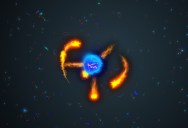Nuclear Fusion Reaches Historic Milestone
For the first time in human history, physicists achieved nuclear fusion at the Lawrence Livermore National Laboratory’s National Ignition Facility (NIF) on December 5, 2022.

Photo Credit: Pixabay
Technically, the lab created controlled nuclear fusion by releasing more energy than put in, but there is room for improvement within both the physics and engineering parts of the process. The equation for releasing the same amount of energy you put in is Q = 1, the December 5th event achieved Q = 1.54, but online commentators believe that Q = 10 would be needed for a commercial reactor.
To fully appreciate the latest NIF accomplishment, it helps to understand how nuclear fusion works in nature. Nuclear fusion powers the Sun and stars as hydrogen atoms fuse together to form helium, and the matter is converted into energy. Two light nuclei merge to form a single heavier nucleus and the process releases energy because the mass of the original elements is greater than the products.

Photo Credit: Pexels
The amount of energy produced during nuclear fusion is related to each element’s atomic weight. Hydrogen is the easiest element to fuse because it has only one proton in its nucleus. The more positively charged particles in the element, the less energy you get out.
Fusion in the lab aims to mimic nature with different reactor designs that push atoms together. However, scientists use less hydrogen and higher temperatures.
The design that achieved success at NIF used inertial confinement (ICF) by laser. In this process, a heavy hydrogen pellet is first placed in a tiny cylinder, which is then shot by a laser and instantly vaporized. As it turns into plasma it shoots inwards, where it meets hydrogen (or other nuclear fuel) with a force great enough to compress and fuse the fuel.
The other leading tokamak and stellarator designs also use ICF but instead hold the hydrogen plasma within a magnetic field. It is then heated to temperatures higher than the center of the sun. So far, these approaches have not produced enough energy in the plasma to keep the plasma hot. Scientists in the south of France are currently building a full-scale tokamak reactor, the International Thermonuclear Experimental Reactor (ITER), to conduct the world’s largest fusion experiment.

Photo Credit: Pexels
As nuclear fusion moves from concept to reality, people are concerned about the safety and environmental implications of this energy source. For the most part, nuclear fusion is safe and clean. Nuclear fusion power plants would not be at risk for a nuclear meltdown because if needed, the plasma cools down and ceases being fuel. While it doesn’t emit carbon dioxide, nuclear fusion still produces nuclear waste, albeit much less than nuclear fission power plants.
The resources needed for nuclear fusion are abundant in nature, but we would need to exercise great caution to make it a large-scale energy source. How we extract the elements from the environment and approach the weapons-grade nuclear compounds produced by fusion power will determine the safety and sustainability of the technology.
While the path to nuclear fusion just celebrated a major victory, significant research and testing are still needed before we can realize a future of unlimited carbon-free energy.

Sign up to get our BEST stories of the week straight to your inbox.




